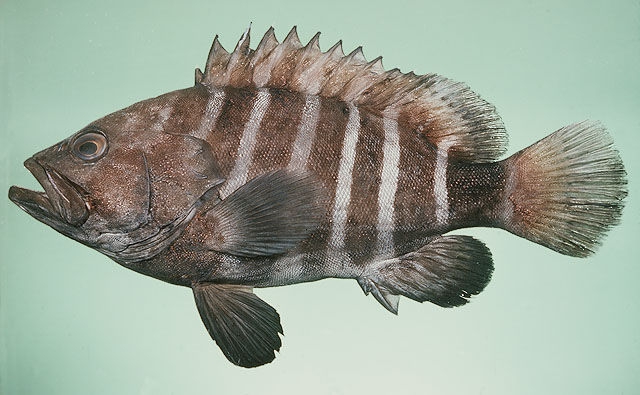| Taxon ID: 28,879 Total records: 39,143 | ||||||||||||||
Hyporthodus octofasciatus
Country
| Country | Singapore |
|---|---|
| Continent Ocean | Asia |
Classification
| Kingdom | Animalia (COL) |
|---|---|
| Phylum | Chordata (COL) |
| Class | Actinopterygii (COL) |
| Order | Perciformes (COL) |
| Family | Serranidae (COL) |
Taxonomy
| Genus | Hyporthodus | Reference | |
|---|---|---|---|
| SubGenus | Vernacular Name | ||
| Species | octofasciatus | IUCN Threat Status-Year | Data Deficient, 2008 |
| SubSpecies | Nat'l Threat Status-Year | Not Evaluated, 2000 | |
| Infraspecies | Reason for Change | ||
| Infraspecies Rank | CITES | ||
| Taxonomic Group | Fish | Native Status | Native |
| Scientific Name Author | (Griffin, 1926) | Country Distribution | Singapore |
| Citation | Description | Indo-West Pacific: Somalia and South Africa to Japan, Australia and New Zealand. Except for Japan, China, and Korea, most distribution records for Epinephelus septemfasciatus are probably based on this species. Reported as Epinephelus compres
Geographic Range [top]
Range Description: Hyporthodus otofasciatus is an Indo-West Pacific species ranging west to Somalia and South Africa, to China, Korea and Japan, south to Australia and New Zealand and east to the Marquesas. No information on important sites, areas of occupancy nor extent of occurrence (except for the distribution map) is available.
Countries occurrence:
Native:
Australia; Bahrain; British Indian Ocean Territory; China; Disputed Territory; Djibouti; Eritrea; Fiji; French Polynesia; India; Indonesia; Iran, Islamic Republic of; Iraq; Japan; Kenya; Korea, Republic of; Kuwait; Madagascar; Maldives; Mauritius; Micronesia, Federated States of ; Mozambique; Myanmar; New Caledonia; New Zealand; Niue; Norfolk Island; Northern Mariana Islands; Oman; Papua New Guinea; Qatar; Réunion; Saudi Arabia; Solomon Islands; Somalia; South Africa; Sri Lanka; Taiwan, Province of China; Tanzania, United Republic of; Thailand; Tonga; Tuvalu; United Arab Emirates; Vanuatu; Yemen
FAO Marine Fishing Areas:
Native:
Indian Ocean – western; Indian Ocean – eastern; Pacific – northwest; Pacific – southwest; Pacific – western central
Additional data:
? Lower depth limit (metres): 300
? Upper depth limit (metres): 150
Range Map: Click here to open the map viewer and explore range.
Population [top]
Population: General
Hyporthodus otofasciatus is a rare species throughout its range.
Fisheries-dependent data
Quantitative fishery data are lacking as catches of this species are probably lumped with other groupers) (Sean Fennessy pers. comm.). Qualitative information suggests that this species could be found along the whole northwest coast of Australia and one specimen weighing 66 kg was caught in Scott Reef from 200 m depth (John Choat pers. comm.). Quantitative data suggest that medium amounts of this species are landed annually in Western Australia, and the quantity is increasing, from 5,800 kg in 2001 to 72,100 kg in 2005 (Mark Cliff pers. comm.). Direct estimation of CPUE using available information on the number of vessel involved in such fisheries reveals a four times increase in CPUE during the period, from 322 kg/vessel (2001) to 1,441 kg/vessel (2005) (vessel irrespective of type). The landings of this species in Guam from 1998 to 2002 fluctuated bi-annually, but dramatically increased form 3 kg in 1992 to 1,530 kg in 1994 (annual mean: 392 kg) (data provided from Sea Around Us Project). Its true abundance may be overlooked due to its preference to live in relatively deeper water (150 to 300 m) (Froese and Pauly 2006), leading to decreased encounter rate from underwater survey and most shallow-waters fisheries.
Current Population Trend: Unknown
Additional data:
? Population severely fragmented: No
Habitat and Ecology [top]
Habitat and Ecology: Hyporthodus otofasciatus favors deep (150 to 300 m) rocky reefs (Heemstra and Randall 1993). It is reported to have a maximum life span to 56 years (FAO 2003).
Systems: Marine
Threats [top]
Major Threat(s): Hyporthodus otofasciatus is primarily threatened from the commercial (also likely by recreational) fisheries. The magnitude of the fishing pressure is not clear within the range of distribution but its scale of fishery is likely to be relatively small (Heemstra and Randall 1993). Quantitative information is lacking for evaluating its importance and involvement into fisheries within its range of distribution.
Conservation Actions [top]
Conservation Actions: Available information suggests that Hyporthodus otofasciatus has not been recorded within marine reserve in South Africa and Mozambique (reported from dive surveys from 1987 to 1992) (Chater et al. 1993; Chater et al. 1995). Information from other regions is lacking. There is no known specific fishery regulation or management on this species.
Citation: To, A.W.L. & Pollard, D. 2008. Hyporthodus octofasciatus. The IUCN Red List of Threatened Species 2008: e.T132772A3447316. http://dx.doi.org/10.2305/IUCN.UK.2008.RLTS.T132772A3447316.en. Downloaded on 03 May 2017.
Disclaimer: To make use of this information, please check the |
|
| Source | http://www.fishbase.org |
Record Level
Growth Parameters
| Temperature | 0 | Observed Weight | 0 |
|---|---|---|---|
| Sex | Previous Catalog Number | ||
| Life Stage | Relationship Type | ||
| Preparation Type | Related Catalog Item | ||
| Individual Count | 0 | GML Features | |
| Observerd Individual Count | 0 | Notes |
Collecting Event
Images
|
Additional Info
Synonyms To Manage Synonyms for Hyporthodus octofasciatus, click this link: Synonyms. |
Epinephelus compressus Postel, Fourmanoir & Guézé, 1963 ¦ Epinephelus grammatophorus (non Boulenger, 1903) ¦ Epinephelus mystacinus (non Poey, 1852) ¦ Epinephelus octofasciatus Griffin, 1926 ¦ Epinephelus septemfasciatus (non Thunberg, 1793) ¦ Serranus mystacinus (non Poey, 1852) ¦ |
Common Names To Manage Common Names for Hyporthodus octofasciatus, click this link: Common Names. |
Rockcod () |
Localities To Manage Localities for Hyporthodus octofasciatus, click this link: Localities. |
Species Record Updated By:
Carlos Aurelio Callangan
|

